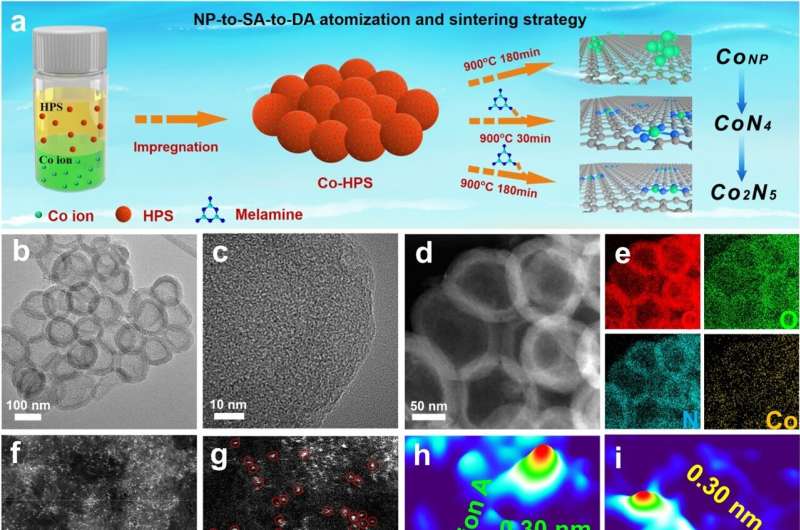This article has been reviewed according to Science X's editorial process and policies. Editors have highlighted the following attributes while ensuring the content's credibility:
fact-checked
peer-reviewed publication
trusted source
proofread
Developments in dual-atom catalysts make renewable energy sources more efficient

The rapidly developing field of green energy constantly seeks improvements, and recent advances in dual-atom catalysts hold the potential to revolutionize energy conversion technologies.
In the pursuit of sustainable alternatives to carbon-based energy sources, the need for quick, efficient, and scalable technologies is crucial. Water-splitting systems (WWSs), relying on solar-powered batteries, offer a promising solution. However, the intricate and slow reaction steps inherent in WWSs limit their scalability for widespread use.
Researchers from the Qingdao Institute of Bioenergy and Bioprocess Technology of the Chinese Academy of Sciences sought an improved design to increase the speed and stability of the main half reactions needed for WSSs to function at a high caliber: oxygen reduction reactions, oxygen evolution reactions, and hydrogen evolution reactions.
It turns out that dual atom catalysts, bridging single atom and metal/alloy nanoparticle catalysts, offer more opportunities to improve the kinetics and multifunctional performance of oxygen reduction/evolution and hydrogen evolution reactions.
Their results were published in Nature Communications.
"Oxygen reduction/evolution and hydrogen evolution reactions are the core reactions, involving multi-proton-electron coupling processes, which are kinetically slow, so it is urgent to develop efficient, stable and low-cost electrocatalytic materials to improve their conversion efficiency," said Jiang Heqing, corresponding author on the study.
Dual atom catalysts (DACs), in contrast to single atom catalysts (SACs), which have only one metal atom per active site, play a pivotal role in the field of energy catalysis due to their advantageous multifunctional catalytic activity, higher atomic utilization efficiency, and more effective disruption of the linear relationship with reaction intermediates.
Moreover, the application of SACs to energy conversion systems will significantly limit energy conversion efficiency due to the higher reaction barriers.
DACs benefit from the synergistic effect between their dual metal atoms, enabling effective modulation of cooperative effects between dual active sites and a substantial reduction in the energy barriers required for the reaction.
Based on the advantages of the DACs, exploring their synthesis mechanism through high-temperature sintering strategies is crucial to advance their preparation and facilitate commercial applications.
"We reported a novel atomization/sintering strategy to synthesize and tune the configuration states of cobalt (Co) species at the atomic level, from nanoparticles to single-atom to dual-atom," said Huang Minghua, another author and researcher who contributed to the study.
The atomization/sintering strategy involves the conversion of cobalt into nanoparticles (atomization), which are then used to form a single atom (SA) and dual atom (DA) species through the process of sintering.
One of the more impressive features of this strategy and the findings from this research are the applications atomization/sintering can have to make 21 other DACs. This is all thanks to observing how these DACs form via the atomization/sintering process. The more DACs there are, the more opportunities are available to explore other means to better harness energy sustainably.
Testing the capabilities of the dual-atom Co2N5 in zinc-air batteries showed promising results. The Zn-air batteries had a stability of 800 hours and allowed for continuous water splitting for 1,000 hours at a time, demonstrating the potential for uninterrupted operation even during the night.
Work on DACs is ongoing. "This universal and scalable strategy provides opportunities for the controlled design of efficient multifunctional dual atom catalysts in energy conversion technologies," said Jiang Heqing.
Further developments can be made to continue improving the abilities of bimetallic catalysts. Seeing how they perform under different circumstances can also be instructive, such as how the water-splitting system handles cold temperatures or seawater. Placing these systems in adverse conditions can highlight difficulties that need to be worked out that can be a hindrance to large-scale or commercial use.
More information: Xingkun Wang et al, Developing a class of dual atom materials for multifunctional catalytic reactions, Nature Communications (2023). DOI: 10.1038/s41467-023-42756-8
Journal information: Nature Communications
Provided by Chinese Academy of Sciences





















